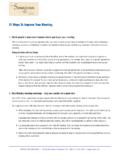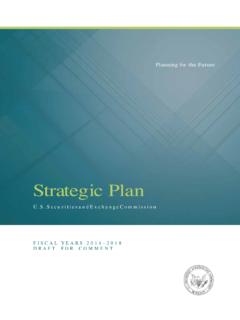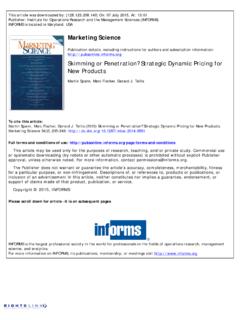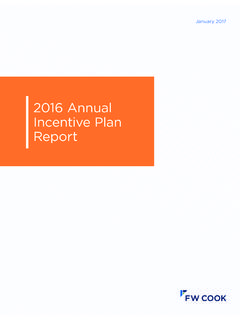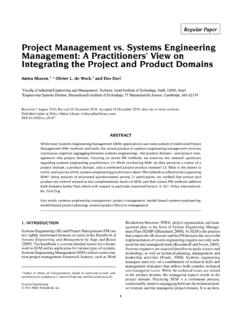Transcription of A “Collaborative” Strategic Planning Process
1 A collaborative Strategic Planning Process A 5 Phase Model This article describes a five phase, collaborative Strategic Planning Process that has worked in a variety of institutions (Saint Joseph's University, Bellarmine University, The University of the West Indies) in higher education. The Process is highly engag- ing and inclusive in nature and efficient in its execution. The Process is designed to create commitment to the implementation of the Strategic plan from the very beginning. It is consultant lite and utilizes a highly credible internal Planning task force as the driving mechanism for the entire Process . It taps into and builds the capacity of the institution to think and plan in collabora- tive and inclusive ways. Campus stakeholders feel heard and valued as their meaningful involvement helps create a bright and robust future for the institution.
2 Biography I am the president of The Sanaghan Group, an organizational consulting firm specializing in collaborative Strategic Planning and leadership transitions in Higher Education. I have worked in over 40 campuses throughout the country. I help teach the NACUBO Integrated Planning and Budgeting Seminar. I have written two books on Planning and change management and many articles on leadership transitions and organizational behavior. I am co-author of a book on Presidential Transitions in Higher Education that will be published by ACE this year. Key Words collaborative Strategic Planning /Concept Papers/Vision Conference/Consultant Lite /Stakeholder Review/Engagement/Preferred Future The 5 Phases are: 1. Getting Organized 2. Data Gathering 3. Sensemaking 4. Vision Conference(s).
3 5. Goals Conference(s). PATRICK SANAGHAN 168 East State Street, Doylestown PA 18901 Guiding Principles/Essential Elements 1. Meaningful engagement of institutional stakeholders is at the heart of the Process . By engagement we mean face-to-face interaction and discussion. 2. Information gathered throughout the Planning Process is shared with everyone. Transparency is essential. 3. The role of the consultant(s) is to help tap into and build the capacity of the internal stakeholders and guide the Planning Process not direct it. 4. Attention is paid to the external issues and trends in higher education throughout the Process so that institutional stakehold- ers don't focus too much on their own world. (We call this listening to yourself too much). 5. External stakeholders (alumni, community, business) are an important part of the Process and are engaged in several phases of the Planning Process .
4 This creates a well-informed and robust plan that intelligently responds to the pace and complexity of change and responds to the different stakeholder interests that surrounds every institution. I. Getting Organized It takes effective Planning and organization to operationalize a collaborative Strategic Planning Process . Good beginnings are essential to the success of the Process ; therefore, the president must do several things to ensure that an effective and efficient Planning Process takes place: A. Communicate to the campus that the Strategic Planning Process is important to the future of the institution and show their real interest, if not, enthusiasm for an inclusive, participative and transparent Process . This has to be done throughout the Process and not just at the beginning.
5 B. Establish a highly credible Strategic Planning task force (PTF). C. Commit the technological resources to the Planning Process to ensure that everyone knows how to be involved, can con- tribute their ideas and feedback to the Process and be fully informed through Planning updates. D. Clarify his/her role in the Planning Process as a champion and supporter but not a driver or controller of the Process . E. Visibly and authentically support the Process by attending training sessions, communicating with the diverse stakeholder groups throughout the campus about the Process and, most importantly, listening to people's concerns and aspirations. Establishing the Planning Task Force (PTF). The key to the success of a collaborative Strategic Planning Process is a highly credible task force.
6 The composition of the PTF. will make or break the Planning effort. Each task force member must have an excellent reputation and be willing to work hard over the course of the Process . The PTF is both a thinking and doing group. It is best to have two co-chairs, preferably a faculty member and a high level administrator ( CBO, Vice President). Selecting PATRICK SANAGHAN 168 East State Street, Doylestown PA 18901 the co-chairs is the first Strategic thing the president does and will communicate volumes about the importance of the Planning Process and its potential for success. Choose wisely. The external consultant talks with the PTF co-chairs weekly to ensure quality communication. The ideal number of task force members is somewhere between 20 & 30 highly credible individuals.
7 Although we have worked with task forces of 60+, it can be challenging to work with such a large group. Advice on selecting PTF members: 1. The composition must reflect the diversity of the institution. 2. Try and avoid the usual suspects and include some individuals who rarely are asked to the table. 3. Include informal leaders who may not have a title, but have huge peer influence. 4. Each member should have an excellent reputation and respect for the institution. 5. The mix should be about 60% faculty and 40% staff and administrators. It is essential that faculty believe that they are well-represented or your Planning Process will fail. 6. Try to include one or two curmudgeons , those individuals who are known for their skeptical attitudes and are most willing to share them.
8 This will help provide rigor and credibility to the Process . Do not have deeply cynical individuals on the task force. They will never be convinced of its authenticity and will only drag the Process down. Skeptics are welcome, cynics need not apply. 7. The President's Cabinet should be well-represented on the task force because, at the end of the day, they will be charged to implement it. Initial responsibilities of the task force include: 1) establishing a calendar of events for the year; 2) developing a communication plan, 3) identifying forums for engagement and data gathering ( , faculty senate meetings, staff and administrative councils, student government, etc.) and; 4) learning about collaborative Planning and meeting designs that engage stakeholders thinking and passions.
9 II. Data Gathering and Engagement The heart of collaborative Planning is the meaningful engagement of stakeholders throughout the institution. Engagement means face-to-face interaction, discussion and dialogue. Although surveys have a role in any Planning Process , they are sec- ondary in this kind of Planning . At the beginning of the Planning Process , a consultant works with the entire Planning task force for two full days and shares a wide variety of highly interactive Planning activities. Each of the activities creates real data from PTF members and teaches them how to utilize the activities. It is expected that once the PTF members experience the effectiveness and efficacy of the Planning activities, they will then go out and engage a variety of stakeholders throughout the institution.
10 A Stakeholder Review is con- ducted to provide a clear picture of who needs to be connected to and informed about the Planning Process as it moves forward. Before the end of the second day, task force members organize themselves and create an engagement plan for the next two months. They will work in pairs to support each other and will engage faculty, staff, and administrators throughout the campus as well as external stakeholders. It is rather easy to meaningfully engage well over a thousand people over the course of two months. (Recently, we were involved with a regional university where 5000 stakeholders were engaged.). Building the capacity of the task force members to implement the collaborative Planning Process does several things: 1) the task force members own the Process because they are at the heart of it; 2) internal stakeholders witness their own people working hard to create an effective Planning Process ; 3) it builds tremendous credibility for the Planning Process because it is PATRICK SANAGHAN 168 East State Street, Doylestown PA 18901 something that is led by insiders and not by outsiders; 4) it builds the ongoing capacity of the task force members to continue to do collaborative Planning in their own departments ( self-studies) and administrative units after the Planning Process is completed and.
